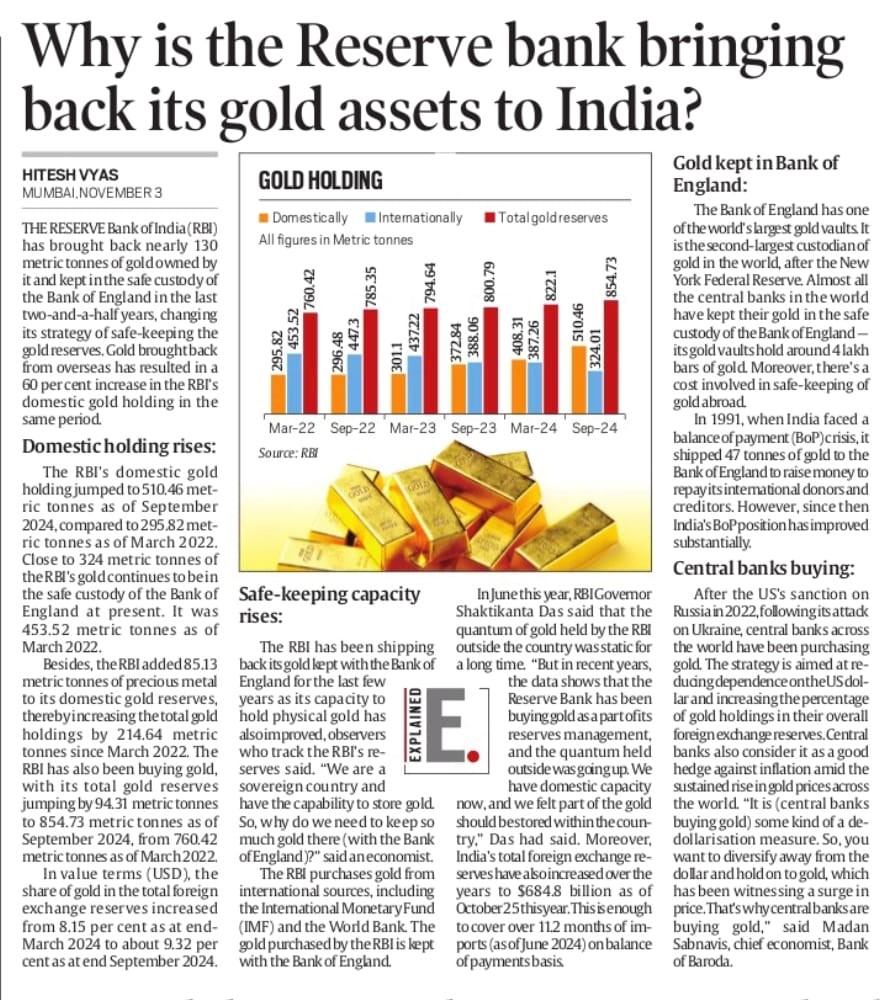Why is the Reserve Bank Bringing Back its Gold Assets to India?
Relevance: GS – 3 – Indian Economy and issues relating to planning, mobilization, of resources, growth, development and employment.
Why in the News?
- The Reserve Bank of India (RBI) has retrieved approximately 130 metric tonnes of gold previously held in safe custody with the Bank of England over the last two-and-a-half years.
- This strategic shift marks a significant change in RBI’s approach to gold reserves, prioritizing domestic storage over overseas custody.
- As a result, RBI’s domestic gold holdings have surged by 60% within the same period.
- The move highlights RBI’s efforts to secure its gold assets domestically, reflecting a shift in reserve management strategy.
Domestic Gold Holdings Rise
- Increase in Domestic Holdings: RBI’s domestic gold holdings surged to 510.46 metric tonnes as of September 2024, up from 295.82 metric tonnes in March 2022.
- Gold Stored Overseas: Currently, around 324 metric tonnes of RBI’s gold remains with the Bank of England, down from 453.52 metric tonnes in March 2022.
- New Additions to Reserves: Since March 2022, RBI has added 85.13 metric tonnes to its domestic gold reserves, increasing total holdings by 214.64 metric tonnes.
- Growth in Overall Gold Reserves: RBI’s total gold reserves have increased by 94.31 metric tonnes, reaching 854.73 metric tonnes in September 2024, compared to 760.42 metric tonnes in March 2022.
- Rising Share in Foreign Exchange Reserves: In value terms (USD), the share of gold in RBI’s total foreign exchange reserves rose from 8.15% in March 2024 to approximately 9.32% by the end of September 2024.
Safe-Keeping Capacity Rises
- Improved Domestic Storage: RBI has enhanced its capacity to store physical gold domestically, prompting the return of gold kept with the Bank of England.
- Rationale for Repatriation: An economist noted that, as a sovereign nation with the capability to store gold securely, there is less need to keep a significant portion of RBI’s gold abroad.
- Gold Acquisition from International Sources: RBI continues to purchase gold from international entities like the International Monetary Fund (IMF) and the World Bank, typically held with the Bank of England.
- RBI’s Strategic Shift: In June 2024, RBI Governor Shaktikanta Das highlighted that while the overseas gold holdings had remained static for a long period, recent data show an increase in domestic gold purchases as part of RBI’s reserve management strategy.
- Increase in Foreign Exchange Reserves: India’s total foreign exchange reserves reached $684.8 billion as of October 25, 2024, sufficient to cover more than 11.2 months of imports based on the balance of payments data from June 2024.
Gold Kept in the Bank of England
- Global Custodian of Gold: The Bank of England holds one of the world’s largest gold vaults, making it the second-largest gold custodian globally, following the New York Federal Reserve.
- Preferred Storage for Central Banks: Nearly all central banks worldwide store their gold in the Bank of England’s secure vaults, which hold around 400,000 bars of gold.
- Safe-Keeping Costs: Storing gold overseas, such as in the Bank of England, incurs maintenance and security costs.
- Historical Context: During India’s balance of payments (BoP) crisis in 1991, the country shipped 47 tonnes of gold to the Bank of England to raise funds for repaying international creditors. India’s BoP position has since seen substantial improvement.
Central Banks Increasing Gold Purchases
- Geopolitical Tensions – Shift After US Sanctions on Russia: Following US sanctions on Russia in 2022 due to the Ukraine conflict, central banks globally have been buying more gold.
- Reduced Dollar Dependence: This trend reflects efforts to decrease reliance on the US dollar by increasing gold’s share within foreign exchange reserves.
- Inflationary Pressures – Inflation Hedge: Central banks view gold as a strong inflation hedge, particularly as global gold prices continue to rise.
- Move Toward De-Dollarisation: According to Madan Sabnavis, chief economist at Bank of Baroda, this shift represents a “de-dollarisation” measure, diversifying reserves away from the dollar and capitalizing on gold’s value surge.
Implications for Global Financial Stability and Currency Reliance:
- Reduced Dollar Dominance: Increased demand for gold could lead to a decline in the dominance of the US dollar, potentially impacting global financial markets.
- Increased Volatility: Shifts in central bank preferences and market sentiment can lead to increased volatility in gold prices.
- Diversification of Reserves: Countries may diversify their reserves to include more gold, reducing their exposure to currency risk.
- Potential for New Monetary Systems: In the long term, this trend could contribute to the development of new monetary systems that are less reliant on traditional fiat currencies.
Way Forward to Gold Reserve Management practices
- Strengthen Domestic Storage: Further enhance domestic storage facilities to accommodate increasing gold reserves.
- Diversify Reserve Portfolio: Continue to diversify the reserve portfolio to reduce reliance on any single asset class.
- Monitor Global Economic Trends: Stay updated on global economic trends and adjust the reserve strategy accordingly.
- Transparency and Accountability: Maintain transparency in reserve management practices and adhere to international best practices.
- Strategic Partnerships: Explore strategic partnerships with other central banks to optimize gold management.
- Risk Management: Implement robust risk management frameworks to mitigate potential risks associated with gold holdings.
Associate articles
https://universalinstitutions.com/tag/rbi-gold-reserves-update/
Source: The Indian Express
Mains question
Discuss the recent trend of central banks increasing their gold reserves globally. Analyze the factors driving this shift and its implications for global financial stability and currency reliance. (250 words)




